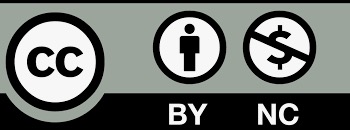Published
2023-08-30
Issue
Section
Research Articles
License
The journal adopts the Attribution-NonCommercial 4.0 International (CC BY-NC 4.0), which means that anyone can reuse and redistribute the materials for non-commercial purposes as long as you follow the license terms and the original source is properly cited.
Author(s) shall retain the copyright of their work and grant the Journal/Publisher rights for the first publication with the work concurrently licensed since 2023 Vol.8 No.2.
Under this license, author(s) will allow third parties to download, reuse, reprint, modify, distribute and/or copy the content under the condition that the authors are given credit. No permission is required from the authors or the publisher.
This broad license intends to facilitate free access, as well as the unrestricted use of original works of all types. This ensures that the published work is freely and openly available in perpetuity.
By providing open access, the following benefits are brought about:
- Higher Visibility, Availability and Citations-free and unlimited accessibility of the publication over the internet without any restrictions increases citation of the article.
- Ease of search-publications are easily searchable in search engines and indexing databases.
- Rapid Publication – accepted papers are immediately published online.
- Available for free download immediately after publication at https://esp.as-pub.com/index.php/ESP

Copyright Statement
1.The authors certify that the submitted manuscripts are original works, do not infringe the rights of others, are free from academic misconduct and confidentiality issues, and that there are no disputes over the authorship scheme of the collaborative articles. In case of infringement, academic misconduct and confidentiality issues, as well as disputes over the authorship scheme, all responsibilities will be borne by the authors.
2. The author agrees to grant the Editorial Office of Environment and Social Psychology a licence to use the reproduction right, distribution right, information network dissemination right, performance right, translation right, and compilation right of the submitted manuscript, including the work as a whole, as well as the diagrams, tables, abstracts, and any other parts that can be extracted from the work and used in accordance with the characteristics of the journal. The Editorial Board of Environment and Social Psychology has the right to use and sub-licence the above mentioned works for wide dissemination in print, electronic and online versions, and, in accordance with the characteristics of the periodical, for the period of legal protection of the property right of the copyright in the work, and for the territorial scope of the work throughout the world.
3. The authors are entitled to the copyright of their works under the relevant laws of Singapore, provided that they do not exercise their rights in a manner prejudicial to the interests of the Journal.
About Licence
Environment and Social Psychology is an open access journal and all published work is available under the Creative Commons Licence, Authors shall retain copyright of their work and grant the journal/publisher the right of first publication, and their work shall be licensed under the Attribution-NonCommercial 4.0 International (CC BY-NC 4.0).
Under this licence, the author grants permission to third parties to download, reuse, reprint, modify, distribute and/or copy the content with attribution to the author. No permission from the author or publisher is required.
This broad licence is intended to facilitate free access to and unrestricted use of original works of all kinds. This ensures that published works remain free and accessible in perpetuity. Submitted manuscripts, once accepted, are immediately available to the public and permanently accessible free of charge on the journal’s official website (https://esp.as-pub.com/index.php/ESP). Allowing users to read, download, copy, print, search for or link to the full text of the article, or use it for other legal purposes. However, the use of the work must retain the author's signature, be limited to non-commercial purposes, and not be interpretative.
Click to download <Agreement on the Licence for the Use of Copyright on Environmental and Social Psychology>.
How to Cite
Sustainable Development Goals (SDGs) and education for Rohingya refugees in Malaysia
Aizat Khairi
Department of General Study, Universiti Kuala Lumpur MIMET
http://orcid.org/0000-0003-2971-5360
Ibrahim Ahmad
Department of General Study, Universiti Kuala Lumpur RCMP
Suadi Zainal
Department of Sociology, Universitas Malikussaleh
DOI: https://doi.org/10.54517/esp.v8i2.1915
Keywords: Sustainable Development Goals (SDGs), Rohingya refugees, UNHCR, education, Malaysia
Abstract
The Sustainable Development Goals (SDGs) and education for Rohingya refugees in Malaysia are examined in this paper. The Sustainable Development Goals (SDGs) serve as a blueprint for achieving a better and more sustainable future for all. Its fourth goal is to improve educational quality and enable socioeconomic mobility to help people escape poverty. The problem for Rohingya refugees in Malaysia is that they are not officially recognized by the host government. This study has been conducted using a qualitative approach. Purposive sampling has been chosen to identify respondents like United Nations High Commissioner for Refugees(UNHCR) personnel, Rohingya refugees, and local non-governmental organizations (NGOs). A semi-structured interview question was used to collect the information from the respondents. As a result, one of the consequences is that their children are not permitted to attend government-run schools for formal education. This situation has left them dissatisfied and concerned about their future in Malaysia. Nonetheless, in order to leverage the SDGs’ goal and achieve its motto of “leaving no one behind”, the UNHCR, as an international UN body, made an effort to provide access to the education sector. These efforts aim not only to improve educational quality, but also to strengthen ties between the refugee community and the host society. The local NGOs also collaborate with UNHCR in terms of financial support to further their secondary and even tertiary study. Despite those challenges, it still strives to achieve the SDG No. 4 target to reach the quality of education for Rohingya refugees. As a result, efforts to improve education for Rohingyas in Malaysia are ongoing, and all stakeholders must work together to make it a reality.Author Biography
Aizat Khairi, Department of General Study, Universiti Kuala Lumpur MIMET
AIZAT KHAIRI, born in Taiping, Perak and currently residing in Seri Manjung, Perak. Obtained a Ph.D Degree in Political Science (Conflict and Peace) from the Research and Education Unit for Peace (REPUSM), School of Social Sciences, Universiti Sains Malaysia (USM).
He is currently working as the Head of Student Development Department and Senior Lecturer at the General Studies Section, Universiti Kuala Lumpur Malaysian Institute of Marine Engineering Technology (UniKL MIMET), Lumut, Perak. He is a lifetime member of the Malaysian Social Science Association and a Committee Member of the Perak Branch of the Malaysian Historical Society.
He has presented research results and papers in the country and abroad. He is also active in producing journal articles, books, writing in magazines and social media. His research specializations include refugees and migration, conflict and peace, human security, politics, ethnic relations, Malaysian studies and Malay civilization.
References
[1]. Gatrell P. Raw material: UNHCR’s individual case files as a historical source, 1951–75. History Workshop Journal 2021; 92: 226–241. doi: 10.1093/hwj/dbab019
[2]. UNHCR. Asylum in the UK. United Nations high commissioner for refugees. Available online: https://www.unhcr.org/uk/asylum-uk (accessed on 24 August 2023).
[3]. Ghosn F, Chu TS, Simon M, et al. The journey home: Violence, anchoring, and refugee decisions to return. American Political Science Review 2021; 115(3): 982–998. doi: 10.1017/S0003055421000344
[4]. Fauzan F, Helmi H, Harza Z, Oktavia S. Capacity building and market intervention for refugees: A study of current and future direction towards sustainable refugee management. Andalas Journal of International Studies 2020; 9(1): 48–60. doi: 10.25077/ajis.9.1.48-60.2020
[5]. Pascucci E. More logistics, less aid: Humanitarian-business partnerships and sustainability in the refugee camp. World Development 2021; 142: 105424. doi: 10.1016/j.worlddev.2021.105424
[6]. Nadin P. The United Nations: A history of success and failure. Australian Quarterly 2019; 90(4): 11–17.
[7]. Wahab AA, Khairi A. Smuggling of Rohingyas from Myanmar to Malaysia: A threat to human security. Akademika 2020; 90(3): 27–37.
[8]. Khairi A, Ladiqi S, Rashidi SN. Lesson learned of Rohingya persecution in Myanmar for sustainable development and policy transformation in Malaysia. Journal of Public Administration and Government 2020; 2(2): 72–77. doi: 10.22487/jpag.v2i2.108
[9]. Khairi A, Na’eim Ajis M. Human security, United Nations and Rohingya refugees in Malaysia. Journal Community 2016; 2(3): 256–269. doi: 10.35308/jcpds.v2i3.95
[10]. Wahab AA, Khairi A. Moving onward: Transnationalism and factors influencing Rohingyas’ migration from Bangladesh to Malaysia. Journal of Nusantara Studies 2019; 4(1): 49–68. doi: 10.24200/jonus.vol4iss1
[11]. Khairi A, Askandar K, Wahab AA. From Myanmar to Malaysia: Protracted refugee situations of Rohingya people. International Journal of Engineering and Technology 2018; 7: 192–196. doi: 10.14419/ijet.v7i3.25.17545
[12]. Khairi A, Wahab AA. The smuggling activity and irregular migration to Malaysia: A case study of the Muslim Rohingya from Myanmar. Global Journal Al-Thaqafah 2018; 8(1): 73. doi: 10.7187/GJAT072018-6
[13]. Khairi A. The dilemma of Rohingya refugees a boat people: The role of Malaysia, its neighbors and ASEAN. International Journal of Academic Research in Business and Social Sciences 2016; 6(12): 481–489. doi: 10.6007/ijarbss/v6-i12/2512
[14]. Khairi A. From academia to NGO: The role of REPUSM in providing alternative education for Rohingya refugees’ children in Penang Island. International Journal of Innovative Technology and Exploring Engineering 2019; 8(12): 5596–5599. doi: 10.35940/ijitee. L4017.1081219
[15]. Mahaseth H, Banusekar S. Living in the shadows: Rohingya refugees in Malaysia. Asian Journal of International Law 2022; 12(2): 259–266. doi: 10.1017/S2044251322000091
[16]. Nazri AS, Talib Khalid KA, Sulaiman N, Gidah ME. Untangling the needs of refugees in Malaysia: The way forward. Journal of Nusantara Studies 2022; 7(1): 196–220. doi: 10.24200/jonus.vol7iss1
[17]. Kassim A. Transnational marriages among Muslim refugees and their implications on their status and identity: The case of the Rohingyas in Malaysia. Available online: http://repository.tufs.ac.jp/bitstream/10108/93077/1/B182-09.pdf (accessed on 24 August 2023).
[18]. Palik J. Education for Rohingya refugee children in Malaysia. Available online: https://www.prio.org/publications/12325 (accessed on 24 August 2023).
[19]. Farzana KF, Pero SDM, Othman MF. The dream’s door: Educational marginalization of Rohingya children in Malaysia. South Asian Journal of Business and Management Cases 2020; 9(2): 237–246. doi: 10.1177/2277977920905819
[20]. Togoo RR, Ismail FHBM. Security dilemma of Rohingya refugees in Malaysia. Open Journal of Political Science 2021; 11: 12–20. doi: 10.4236/ojps.2021.111002
[21]. Denaro C, Giuffre M. UN Sustainable Development Goals and the “refugee gap”: Leaving refugees behind? Refugee Survey Quarterly 2022; 41(1): 79–107. doi: 10.1093/rsq/hdab017
[22]. Van Den Hoek J, Friedrich HK, Ballasiotes A, et al. Development after displacement: Evaluating the utility of OpenStreetMap data for monitoring sustainable development goal progress in refugee settlements. ISPRS International Journal of Geo-Information 2021; 10(3): 153. doi: 10.3390/ijgi10030153
[23]. Wardeh M, Marques RC. Sustainability in refugee camps: A systematic review and meta-analysis. Sustainability 2021; 13(14): 7686. doi: 10.3390/su13147686
[24]. World Vision. Rohingya Refugees in Bangladesh: Facts, FAQs, and How to Help. World Vision; 2019.
[25]. Torok D, Ball J. Renegotiating identity and agency in everyday oppression: Experiences of forced migrant youth in Malaysia. Social Sciences 2021; 10(8): 296. doi: 10.3390/socsci10080296
[26]. Yunus RM, Azme N, Chen XW, et al. The need to map existing health care services for refugees in Malaysia. Journal of Global Health 2021; 11: 03024. doi: 10.7189/jogh.11.03024







